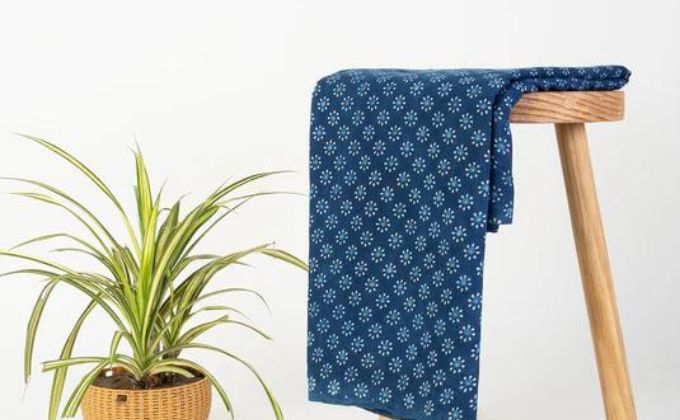Indigo fabric, with its deep, rich blue hues, has been a symbol of timeless elegance for centuries. This natural dye, derived from the indigo plant, has been used in textile art for thousands of years, dating back to ancient civilizations across India, Africa, and Asia. What started as a staple for traditional clothing has now made a powerful resurgence. Blending its ancient roots with modern design to shape contemporary fashion.
In this article, we’ll explore how indigo fabric, with its fascinating history, intricate process, and unique characteristics, continues to influence today’s fashion industry and why it remains a favorite among designers and consumers alike.
The History of Indigo Fabric: A Heritage of Craftsmanship
Indigo fabric has a storied past, with its dyeing process being one of the earliest forms of textile art. The use of natural indigo dye dates back to 2,000 B.C. when it was prized for its vibrant blue color and ability to dye textiles in a long-lasting, deep hue. Ancient civilizations from India, Egypt, Japan, and West Africa all cultivated indigo plants, each developing their own unique techniques for dyeing fabrics.
In India, indigo dye became known as “blue gold,” highly coveted for its use in traditional garments, such as saris, and even exported to other parts of the world. The resulting fabric carries not only stunning color but also cultural significance. A making indigo one of the most revered natural dyes in history.
The Art of Indigo Dyeing: A Complex Process
The beauty of indigo fabric lies not only in its vibrant color but also in the complexity of the dyeing process. Indigo is unique because, unlike many other dyes, it does not dissolve in water. Instead, indigo dye must undergo a fermentation process to release its dyeing properties. The fabric is dipped multiple times into a dye vat, which initially turns the cloth yellow-green. As the fabric is exposed to air, it oxidizes, transforming into the signature deep blue color.
This gradual dyeing process, repeated several times, allows artisans to achieve various shades of indigo, from soft pastel blues to dark, almost-black hues. Each piece of indigo fabric, therefore, carries the skill and precision of the artisans who handcraft it, making it a unique work of art.
Why Indigo Fabric Is Still Relevant in Contemporary Fashion
Today, indigo fabric is making a notable comeback in contemporary fashion, transcending its traditional use to become a staple in modern wardrobes. Here’s why indigo fabric continues to thrive in today’s fashion scene:
- Sustainability and Eco-Friendliness: As consumers and brands become more conscious of the environmental impact of fashion, natural dyes like indigo are gaining popularity. Indigo dye is made from plant-based sources and is biodegradable, making it an eco-friendly alternative to synthetic dyes. Choosing indigo fabric supports sustainable fashion practices and encourages a connection to nature.
- Timeless Style: The deep blue hues of indigo fabric are classic and versatile, allowing for a range of uses in contemporary clothing. Whether in denim, dresses, scarves, or accessories, indigo’s rich color adds a sophisticated, yet relaxed, touch to any outfit.
- Handcrafted Appeal: In an era dominated by mass production, handcrafted indigo fabric stands out as a symbol of quality and artistry. The intricate process of indigo dyeing means that each piece is unique, with slight variations in color and pattern. This handcrafted touch appeals to consumers who value authenticity and craftsmanship in their clothing.
- Versatility in Fashion: Indigo fabric’s versatility allows it to be used in a wide variety of fashion styles. From bohemian and artisanal designs to sleek, minimalist looks, indigo’s deep blue color can seamlessly adapt to different aesthetics. It is a favorite in the world of denim, where it is used in jeans, jackets, and other casual wear. But also in luxury fashion collections for its striking visual impact.
- Cultural Significance: Wearing indigo fabric connects modern consumers to a rich history of textile art and cultural heritage. The dye’s origins in ancient civilizations lend a sense of tradition and depth to today’s fashion pieces and add meaning to the clothing beyond just its aesthetic value.
The Rise of Indigo in Sustainable Fashion
As the fashion industry shifts towards more sustainable practices Synthetic dyes, dominate much of the fast-fashion market. Are often harmful to the environment due to the toxic chemicals involved in their production.
Many sustainable fashion brands are now turning to indigo dye as a natural, earth-friendly alternative. From artisanal clothing lines to eco-conscious denim collections, indigo fabric is leading the way ethically.
Caring for Indigo Fabric
Indigo-dyed fabrics require special care to preserve their beauty. Since natural indigo dye is more prone to fading than synthetic dyes, it’s essential to wash indigo garments carefully. Always wash indigo-dyed fabric in cold water to minimize fading and avoid mixing it with other colors.
Also, Read More Cok News
Conclusion: Indigo Fabric’s Enduring Legacy
Indigo fabric continues to play a transformative role in contemporary fashion, blending its ancient roots with modern design sensibilities. Its natural beauty, sustainable properties, and timeless appeal make it a fabric that resonates with fashion lovers across the globe. Whether you’re looking for a statement piece or a wardrobe staple. Buy now indigo fabric online from Dmaasa offers the perfect combination of traditional and contemporary styles.




